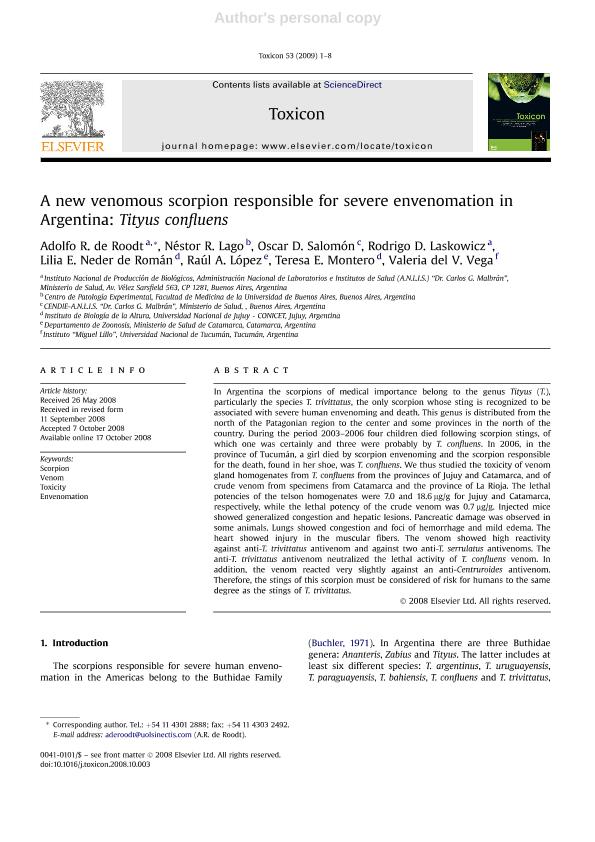Mostrar el registro sencillo del ítem
dc.contributor.author
de Roodt, Adolfo Rafael

dc.contributor.author
Lago, Néstor Rubén

dc.contributor.author
Salomón, Oscar Daniel

dc.contributor.author
Laskowicz, Rodrigo Daniel
dc.contributor.author
Neder, Lilia Estela

dc.contributor.author
López, Raúl Alfredo
dc.contributor.author
Montero, Teresa Eleonor

dc.contributor.author
Vega, Valeria del Valle

dc.date.available
2018-09-28T20:03:31Z
dc.date.issued
2009-01
dc.identifier.citation
de Roodt, Adolfo Rafael; Lago, Néstor Rubén; Salomón, Oscar Daniel; Laskowicz, Rodrigo Daniel; Neder, Lilia Estela; et al.; A new venomous scorpion responsible for severe envenomation in Argentina: Tityus confluens; Pergamon-Elsevier Science Ltd; Toxicon; 53; 1; 1-2009; 1-8
dc.identifier.issn
0041-0101
dc.identifier.uri
http://hdl.handle.net/11336/61305
dc.description.abstract
In Argentina the scorpions of medical importance belong to the genus Tityus (T.), particularly the species T. trivittatus, the only scorpion whose sting is recognized to be associated with severe human envenoming and death. This genus is distributed from the north of the Patagonian region to the center and some provinces in the north of the country. During the period 2003-2006 four children died following scorpion stings, of which one was certainly and three were probably by T. confluens. In 2006, in the province of Tucumán, a girl died by scorpion envenoming and the scorpion responsible for the death, found in her shoe, was T. confluens. We thus studied the toxicity of venom gland homogenates from T. confluens from the provinces of Jujuy and Catamarca, and of crude venom from specimens from Catamarca and the province of La Rioja. The lethal potencies of the telson homogenates were 7.0 and 18.6 μg/g for Jujuy and Catamarca, respectively, while the lethal potency of the crude venom was 0.7 μg/g. Injected mice showed generalized congestion and hepatic lesions. Pancreatic damage was observed in some animals. Lungs showed congestion and foci of hemorrhage and mild edema. The heart showed injury in the muscular fibers. The venom showed high reactivity against anti-T. trivittatus antivenom and against two anti-T. serrulatus antivenoms. The anti-T. trivittatus antivenom neutralized the lethal activity of T. confluens venom. In addition, the venom reacted very slightly against an anti-Centruroides antivenom. Therefore, the stings of this scorpion must be considered of risk for humans to the same degree as the stings of T. trivittatus
dc.format
application/pdf
dc.language.iso
eng
dc.publisher
Pergamon-Elsevier Science Ltd

dc.rights
info:eu-repo/semantics/openAccess
dc.rights.uri
https://creativecommons.org/licenses/by-nc-sa/2.5/ar/
dc.subject
Envenomation
dc.subject
Scorpion
dc.subject
Toxicity
dc.subject
Venom
dc.subject.classification
Toxicología

dc.subject.classification
Medicina Básica

dc.subject.classification
CIENCIAS MÉDICAS Y DE LA SALUD

dc.title
A new venomous scorpion responsible for severe envenomation in Argentina: Tityus confluens
dc.type
info:eu-repo/semantics/article
dc.type
info:ar-repo/semantics/artículo
dc.type
info:eu-repo/semantics/publishedVersion
dc.date.updated
2018-09-18T14:24:23Z
dc.identifier.eissn
1879-3150
dc.journal.volume
53
dc.journal.number
1
dc.journal.pagination
1-8
dc.journal.pais
Países Bajos

dc.journal.ciudad
Amsterdam
dc.description.fil
Fil: de Roodt, Adolfo Rafael. Dirección Nacional de Instituto de Investigación. Administración Nacional de Laboratorio e Instituto de Salud “Dr. C. G. Malbrán”; Argentina
dc.description.fil
Fil: Lago, Néstor Rubén. Universidad de Buenos Aires. Facultad de Medicina. Departamento de Patología. Centro de Patología Experimental; Argentina
dc.description.fil
Fil: Salomón, Oscar Daniel. Dirección Nacional de Instituto de Investigación. Administración Nacional de Laboratorio e Instituto de Salud “Dr. C. G. Malbrán”; Argentina. Ministerio de Salud. Instituto Nacional de Medicina Tropical; Argentina. Consejo Nacional de Investigaciones Científicas y Técnicas. Centro Científico Tecnológico Conicet - Nordeste; Argentina
dc.description.fil
Fil: Laskowicz, Rodrigo Daniel. Dirección Nacional de Instituto de Investigación. Administración Nacional de Laboratorio e Instituto de Salud “Dr. C. G. Malbrán”; Argentina
dc.description.fil
Fil: Neder, Lilia Estela. Universidad Nacional de Jujuy. Instituto de Biología de la Altura; Argentina. Consejo Nacional de Investigaciones Científicas y Técnicas. Centro de Investigaciones y Transferencia de Jujuy. Universidad Nacional de Jujuy. Centro de Investigaciones y Transferencia de Jujuy; Argentina
dc.description.fil
Fil: López, Raúl Alfredo. Provincia de Catamarca; Argentina
dc.description.fil
Fil: Montero, Teresa Eleonor. Universidad Nacional de Jujuy. Instituto de Biología de la Altura; Argentina
dc.description.fil
Fil: Vega, Valeria del Valle. Universidad Nacional de Tucumán. Facultad de Ciencias Naturales e Instituto Miguel Lillo; Argentina
dc.journal.title
Toxicon

dc.relation.alternativeid
info:eu-repo/semantics/altIdentifier/doi/http://dx.doi.org/10.1016/j.toxicon.2008.10.003
dc.relation.alternativeid
info:eu-repo/semantics/altIdentifier/url/https://www.sciencedirect.com/science/article/pii/S0041010108005485
Archivos asociados
